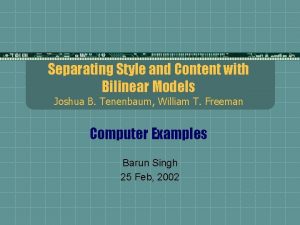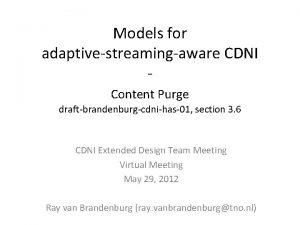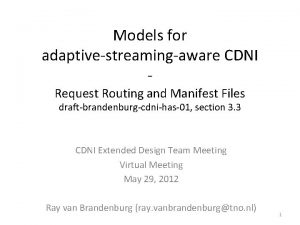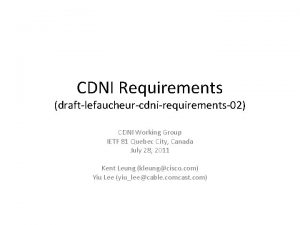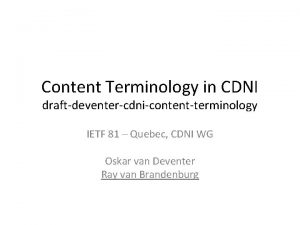Models for adaptivestreamingaware CDNI Content Acquisition and Content






- Slides: 6

Models for adaptive-streaming-aware CDNI - Content Acquisition and Content Collections draft-brandenburg-cdni-has-01, section 3. 2 CDNI Extended Design Team Meeting Virtual Meeting May 29, 2012 Ray van Brandenburg (ray. vanbrandenburg@tno. nl)

Key Considerations regarding Content Acquisition • Content Collection may consists of very large number of files (e. g. 100 s to 1000 s) • Large numbers of files increases transaction overhead when acquiring content from u. CDN by d. CDN – Lots of very small transactions instead of single big one

Option 2. 1: “Do-Nothing” Approach - 1 • Assumes no HAS awareness in u. CDN/d. CDN and no additions to CDNI Interfaces • Result: the d. CDN will acquire each file as a separate independent chunk – i. e. 1000 chunks results in 1000 content acquisition transactions between d. CDN and u. CDN

Option 2. 1: “Do-Nothing” Approach - 2 Effect on CDNI Interfaces: – None Advantages/Drawbacks: + - Extremely flexible, d. CDN only acquires chunks that are necessary Creates more transaction overhead between d. CDN and u. CDN More latency for first client requesting a particular chunk from d. CDN

Option 2. 2: “Allow single file acquisition of fragmented content” - 1 • Might be useful to allow d. CDN to acquire the entire Content Collection in one transaction a) Either as part of a single file (fragmented content), or b) As a folder of files, or c) As a compressed file containing all chunks • Requires HAS awareness in both d. CDN and u. CDN

Option 2. 2: “Allow single file acquisition of fragmented content” - 2 Effect on CDNI Interfaces: – CDNI Metadata Interface: Add fields for indicating the particular type of HAS (e. g. MPEG DASH or HLS) that is used and whether segments or fragments are used – CDNI Metadata Interface: Add field for indicating the name and type of the manifest file(s) Advantages/Drawbacks: + Allows for more efficient content acquisition in all HAS-specific supported forms - Creates bandwidth and storage overhead in case where clients only request a very small portion of the available chunks - Requires full HAS awareness on part of d. CDN/u. CDN - Requires significant CDNI Metadata Interface extensions


